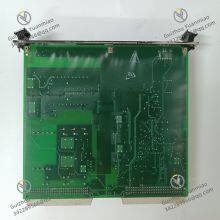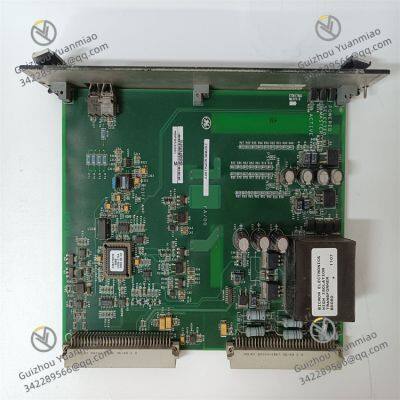Material
Other, Global universal model
Condition
Other, Global universal model
Task
Other, Global universal model
Mathematical Model
Other, Global universal model
Signal
Other, Global universal model
Customized
Non-Customized
Structure
Other, Global universal model
Operating Temperature
-25℃~65℃
Dimensions
100mm×233mm×22mm
Storage Temperature
-40℃~85℃
I. Product Overview
GE IS200ECTBG1ADE is a high-precision signal processing board in the Speedtronic Mark VIe series control system of General Electric (GE), specifically designed for analog signal acquisition, conditioning, and conversion in industrial-grade steam turbines and gas turbines. As the "signal core" of the Mark VIe system, it undertakes the key responsibility of amplifying, filtering, isolating, and digitizing weak analog signals (such as temperature, pressure, and vibration signals) output by on-site sensors. It serves as a core bridge connecting on-site equipment and control modules, ensuring that control modules can obtain accurate and reliable raw data. It is widely used in industrial scenarios with strict requirements for signal acquisition accuracy and anti-interference capability, such as power generation, petrochemicals, and metallurgy.
This board adopts a standard 3U VME industrial board form factor (approximately 100mm in height, 233mm in width, and 22mm in thickness), with no independent operation panel. It realizes data interaction and power supply with control modules and power modules through the system backplane. The surface of the board adopts an industrial-grade anti-interference layout; key signal conditioning chips (such as instrumentation amplifiers and ADC converters) are equipped with metal shields, and the pin soldering process complies with the IPC-A-610 Class 3 industrial standard. It can withstand long-term high-load operation and complex electromagnetic environments (such as motor start-stop and high-frequency interference from frequency converters), ensuring the stability of signal processing functions and data accuracy, and adapting to harsh operating conditions in industrial sites.

II. Technical Parameters
1. Electrical Parameters
Power Supply Requirements: The input voltage is +5V DC (for digital circuits) and ±12V DC (for analog circuits), with an allowable voltage fluctuation range of ±5%; the maximum power consumption is ≤12W. It adopts a natural heat dissipation design (a small heat sink is integrated on the board surface), and the operating temperature is ≤55℃.
Input Channel Parameters:
Thermocouple Channels (8 channels): Supports K/J/T types, with a cold-junction compensation accuracy of ±0.5℃. The measurement range is -200℃~1300℃ (for K-type), and the input impedance is ≥10MΩ;
RTD (Resistance Temperature Detector) Channels (8 channels): Supports PT100/Cu50, using a 3-wire measurement method. The measurement range is -200℃~850℃ (for PT100), and the measurement accuracy is ±0.1% FS;
Standard Signal Channels (8 channels): Supports 4-20mA/0-10V. The input impedance is ≥100kΩ (for voltage signals)/≤250Ω (for current signals), and the conversion accuracy is ±0.05% FS;
ADC Conversion Parameters: 16-bit resolution, sampling rate of 10-100Hz (configurable), conversion time ≤10ms, and input common-mode voltage range of ±10V.
Anti-Interference Performance: Complies with the IEC 61000-6-2 industrial anti-interference standard. It has electrostatic discharge (ESD) protection of ±2kV (contact discharge)/±4kV (air discharge), electrical fast transient (EFT) protection of ±1kV (power port)/±0.5kV (signal port), and radio frequency radiation immunity of ≥10V/m (80-1000MHz).
2. Environmental Parameters
Operating Temperature: -25℃~65℃, supporting wide-temperature operation and adapting to scenarios such as high-temperature workshops and outdoor control cabinets;
Storage Temperature: -40℃~85℃, with no risk of component aging or pin corrosion during long-term storage;
Humidity: 5%~95% (non-condensing). The board surface is coated with a moisture-proof insulating layer, allowing use in high-humidity and high-salt-spray coastal environments;
Vibration Protection: Complies with the IEC 60068-2-6 standard, capable of withstanding sinusoidal vibration with a frequency of 10-500Hz and an acceleration of 5g; complies with the IEC 60068-2-27 standard, capable of withstanding an impact of 50g acceleration (11ms pulse), avoiding interface loosening and component damage caused by equipment operation vibration or transportation impact.
3. Physical and Interface Parameters
Dimensions: 3U VME board form factor (100mm×233mm×22mm), compatible with standard 19-inch industrial control cabinet installation, and supporting hot swapping (requires Mark VIe system authorization);
LED Indicators: 4 status lights (PWR: Power status, green; RUN: Operation status, green; ERR: Fault status, red; COMM: Communication status, yellow). The RUN light blinks to indicate signal acquisition and processing in progress, and the COMM light stays on to indicate normal backplane communication;
Backplane Interface: 1 VME64x backplane interface, used for communication with control modules to transmit collected data and configuration commands, and supports interrupt requests (e.g., triggering an interrupt when a signal exceeds the limit);
Input Interface: 24 Phoenix terminal interfaces (each channel corresponds to 1 signal input + 1 common terminal), supporting screw-fastened wiring, with a wire specification of 0.5-2.5mm².

III. Functional Features
1. Multi-Channel High-Precision Analog Signal Acquisition
With analog signal processing as its core, the IS200ECTBG1ADE integrates 24 differential analog input channels, supporting the acquisition of thermocouples (K-type, J-type, T-type), RTDs (PT100, Cu50), and standard industrial signals (4-20mA, 0-10V), covering mainstream sensor signal types in industrial sites:
For thermocouple signals, the board has a built-in cold-junction compensation circuit with a compensation accuracy of ±0.5℃, ensuring a temperature measurement error of ≤±1℃;
For RTD signals, a 3-wire measurement method is adopted to effectively offset the influence of lead resistance, achieving a measurement accuracy of ±0.1% FS;
For 4-20mA/0-10V signals, weak signals are amplified 10-100 times by an instrumentation amplifier (such as AD8221), and then digitized by a 16-bit high-precision ADC converter (such as ADS1115) with a conversion accuracy of ±0.05% FS and a sampling rate of up to 100Hz, which can capture subtle changes in signals in real time (e.g., high-frequency fluctuations of vibration signals).
2. Multiple Signal Filtering and Anti-Interference
To solve the problem of signal distortion caused by electromagnetic interference in industrial sites, the board has a built-in dual anti-interference mechanism of "hardware filtering + software filtering":
At the hardware level, each signal input channel is connected in series with an RC low-pass filter circuit (the cutoff frequency can be set to 50Hz/60Hz via jumpers) to effectively suppress power frequency interference; it is also equipped with a signal isolation module (such as ISO1540) to achieve electrical isolation between the input signal and the internal circuit of the board (isolation voltage ≥2.5kVrms), preventing the impact of common-mode interference and ground loops;
At the software level, a sliding window filtering algorithm is used to eliminate spike pulse interference, and a Kalman filtering algorithm is combined to smooth signal fluctuations (e.g., instantaneous jumps of pressure signals). After filtering, the signal-to-noise ratio is increased to more than 60dB, ensuring that the data uploaded to the control module truly reflects the actual state of the equipment and avoiding misjudgment of control logic caused by interference.
3. Signal Linearization and Calibration
For nonlinear sensor signals (e.g., the nonlinear relationship between thermoelectric potential and temperature of thermocouples), the IS200ECTBG1ADE has a built-in signal linearization algorithm: by storing the nonlinear correction curve of the sensor (such as the ITS-90 standard curve for K-type thermocouples), it performs real-time linearization processing on the collected raw signals, controlling the nonlinear error within ±0.2%;
At the same time, it supports user-defined calibration functions. Operation and maintenance personnel can perform zero and gain calibration for each channel through GE ToolboxST configuration software—by connecting a standard signal (such as 4mA/20mA), the board automatically corrects the calibration parameters to ensure high-precision measurement is maintained after long-term operation (the recommended calibration cycle is once a year). In addition, the board also has an open-circuit/short-circuit detection function. When the sensor cable is broken or short-circuited, it can quickly identify and trigger an alarm, avoiding monitoring blind spots caused by "no signal".
4. Flexible Data Interaction and Status Monitoring
The board realizes high-speed data interaction with the control module through the VME64x backplane bus, with a transmission rate of 40MB/s. It can upload the digitized data of 24 channels to the control module in real time, while receiving configuration commands issued by the control module (such as sampling rate adjustment and filtering parameter setting);
It is equipped with 4 LED indicators (PWR: Power status, green; RUN: Operation status, green; ERR: Fault status, red; COMM: Communication status, yellow). The ERR light stays on to indicate a hardware fault of the board (such as damage to the ADC chip), and blinks to indicate a signal abnormality (such as an open-circuited sensor);
Through the backplane interface, the board can also upload the acquisition status of each channel (such as whether it is calibrated and whether there is interference) to the monitoring system, facilitating operation and maintenance personnel to remotely check the signal quality and quickly locate faulty channels (e.g., a temperature signal of a certain channel exceeding the limit).












































